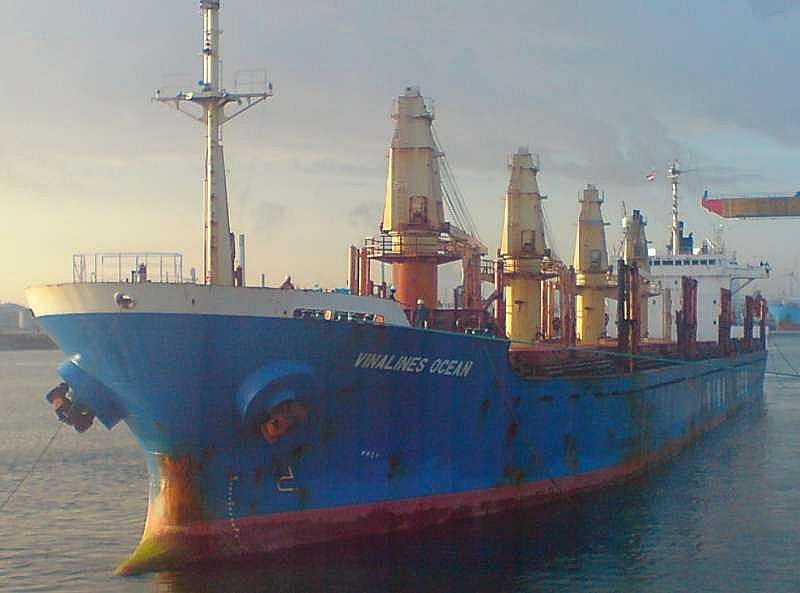Vinalines unable to rid itself of old vessels
 |
| Vinalines Ocean was built over 20 years ago and promises to be a difficult sale |
Auction and competitive offer five times
Vinalines has just requested the Ministry of Transport (MoT)’s approval to reduce the initial selling price of VNL Fortuna, one of the six vessels that they meant to sell in 2017. Vinalines wants to decrease the initial price from $2.45 million to $2.275 million.
At the public auction in February 2018, no investors were interested in buying VNL Fortuna. Thus, Vinalines had to shift to a competitive offer, following international practices.
When the first competitive offer was made in March 2018, Vinalines received ten competitive offer letters for VNL Fortuna. The highest offer was $2.61 million from Oceanic Wit Limited. This was the only price higher than the initial price set by Vinalines.
However, this investor backed out of the transaction and VNL Fortuna stayed on offer until April 2018. At the second offer, Vinalines received eight competitive offer letters, with the highest price of $2.275 million from Athenai Management, a little lower than the initial price.
Nguyen Canh Tinh, acting general director of Vinalines, said that in the ailing vessel market, Athenai’s price could be the best at the time. If Vinalines organised another offer, the order price could be lower, he added.
VNL Fortuna (built in 1991) was bought for $21.7 million in 2007. Including depreciation and the re-evaluation of asset vale, on December 31, 2017 the initial price of $2.45 million is not enough to cover Vinalines’ investment.
At the end of April 2018, Vinalines asked for the decrease of VNL Sky’s initial price after five unsuccessful auctions, where the highest price was VND89.595 billion ($4 million), still $0.41 million lower than the initial price.
Selling below buying price, still a bargain?
Of the six-vessel fleet approved to be sold off in 2017, VNL Green and VNL Ocean have yet to be put on sale. However, the leader of Vinalines confirmed that selling these vessels at this time would be very difficult.
According to Clarksons, a leading consultant on vessel trading over the world, the selling price of used vessels is falling due to an oversupply situation on the market.
Earlier, in 2017, Vinalines sold two of its ships that were more than 20 years old. VNL Star (built in 1993) was sold for VND42.39 billion ($1.87 million), and VNL Trader was sold for $3.535 million. Despite these selling prices being higher than the initial offering price, Vinalines has suffered big losses.
The leader of Vinalines said that if these vessels were built at the present, their costs would be one-third of the 2007 price. Moreover, the older the ships, the lower their prices.
“Regarding the transparency, VNL Sky was offered five times at public auction and through international competitive offer, but investors did not offer the expected price. Selling vessels below book value is absolutely normal if the firm wants to cut losses,” said Tinh.
According to Article 27 of Decree No.91/2015/ND-CP dated October 13, 2015 on state capital investment in enterprises, use and management of capital and assets in enterprises, in case the authorities issue a decision to dispose, transfer or sell fixed assets at a price that cannot recover the full capital invested, state enterprises must clearly state the reasons behind this and report to the representative agency and same-level financial institution prior to the transfer or sale to ensure supervision.
Moreover, all six vessels (VNL Sky, Ocean, Trader, Fortuna, Star, Green) are at the end of their life cycle, which means operating costs are high. Meanwhile, the market is chock full of younger and more modern vessels, meaning the business results of this fleet are expected to be bad.
Vinalines estimates that if the fleet remains in operation, VNL Fortuna will make a loss of VND15.8 billion ($0.7 million) by the end of 2018 and VND38.1 billion ($1.7 million) by 2020. This will be VND15 billion ($0.66 million) and VND40.6 billion ($1.8 million), respectively, for VNL Sky.
“Selling old vessels like VNL Sky and Fortuna is essential to cut losses, restructure the fleet, and reduce the financial burdens of the corporation during equitisation,” Tinh said.
What the stars mean:
★ Poor ★ ★ Promising ★★★ Good ★★★★ Very good ★★★★★ Exceptional
Related Contents
Latest News
More News
- UOB sees Vietnam growth easing in fourth quarter (December 22, 2025 | 17:39)
- Government moves to establish International Financial Centre (December 21, 2025 | 21:00)
- Vietnam's IFC to target global investment flows (December 21, 2025 | 18:00)
- Ha Tinh breaks ground on major Vingroup industrial and energy projects (December 19, 2025 | 18:24)
- EVN launches major power infrastructure projects nationwide (December 19, 2025 | 18:17)
- VAL inaugurates second production line to meet domestic animal feed demand (December 19, 2025 | 16:37)
- Sun Group pioneers urban tram system in Phu Quoc (December 19, 2025 | 15:00)
- Top 10 notable events of Vietnam’s industry and trade sector in 2025 (December 19, 2025 | 14:00)
- Seven major projects launched to drive Hanoi’s next growth phase (December 19, 2025 | 14:00)
- Rare, beautiful, sustainable: the mark of iconic real estate (December 19, 2025 | 08:00)

 Tag:
Tag:

























 Mobile Version
Mobile Version